The 2022 Ford F-150 Lightning isn’t a whiz-bang gadget disguised as a truck. It doesn’t promise full autonomous driving. It’s not styled like something from a sci-fi movie. No, the Lightning is a regular, everyday F-150 with an electric powertrain shoved in, and that’s pretty much it. But this no-nonsense approach is actually the Lightning’s superpower, allowing it to reach the market quickly, remain within a price range that many can afford, and appeal to the masses by being familiar and unintimidating. It’s a key factor behind why I see the launch of the 2022 Ford F-150 Lightning as a major inflection point in automotive history. The other key factor is execution, and after driving the truck last week I can say with confidence: Ford nailed it.
After having driven machines like the Rivian R1T, Tesla Model 3, Kia EV6, Hyundai Ioniq 5, and Honda E, I’ve gotten used to the “weirdness” that tends to accompany EVs. Some might also call it novelty. It’s the wacky column shifter in the Hyundai, the absurd number of electronic gadgets and storage offerings in the Rivian, it’s the Tesla’s humongous screen in an otherwise oddly understated cabin, it’s the whole vibe of the Honda E. These are some great cars I’m mentioning, here, but to most laypeople, they’re kind of weird.
The Ford F-150 Lightning is not weird. Not even a little bit.

This was not the takeaway I was expecting. When I arrived at the F-150 Lightning press event in San Antonio, I figured the truck would be quirky like every other EV I’d driven recently, but at the same time I worried that it would be severely compromised given that it’s clearly built on the same architecture as the gasoline F-150. I was wrong on both counts.

(Full Disclosure: Ford flew me from Detroit to San Antonio, put me up in a nice hotel, and fed me such high quality food that I bet I could blend it up, strain it, and use the juices as starting fluid to fire up an old Ford 300 straight six).
The first point is simple enough: Ford didn’t really weird-ify the Lightning much over the standard F-150. Sure, there’s a big-ass screen in the cabin and there’s a frunk up front — plus the whole face looks a bit different — but by and large, the Lightning is familiar. As for the second point: For years the media and consumers alike have been criticizing EVs that are based on existing gasoline vehicle platforms. “Dedicated EV platforms or bust” has been the widespread sentiment for a while now, with many believing that the compromises associated with trying to adapt a gas platform to fit EV hardware just yield a watered-down product.
I agree with this, but only if we’re talking about adapting unibody vehicles — in other words, vehicles whose structural backbones are integrated into their bodies. As for adapting a body-on-frame machine like the gas F-150 into an EV? I think the compromises are significantly reduced in number and severity, and in fact, I think they’re downright worth making at this point in time. After all, as one Ford engineer put it during lunch: “The frame is the original skateboard.”
We’ll talk about that more later; for now, I’m going to spend quite a bit of time talking about the F-150 Lightning’s hardware.
A Look At The Ford F-150 Lightning’s Hardware
The Body
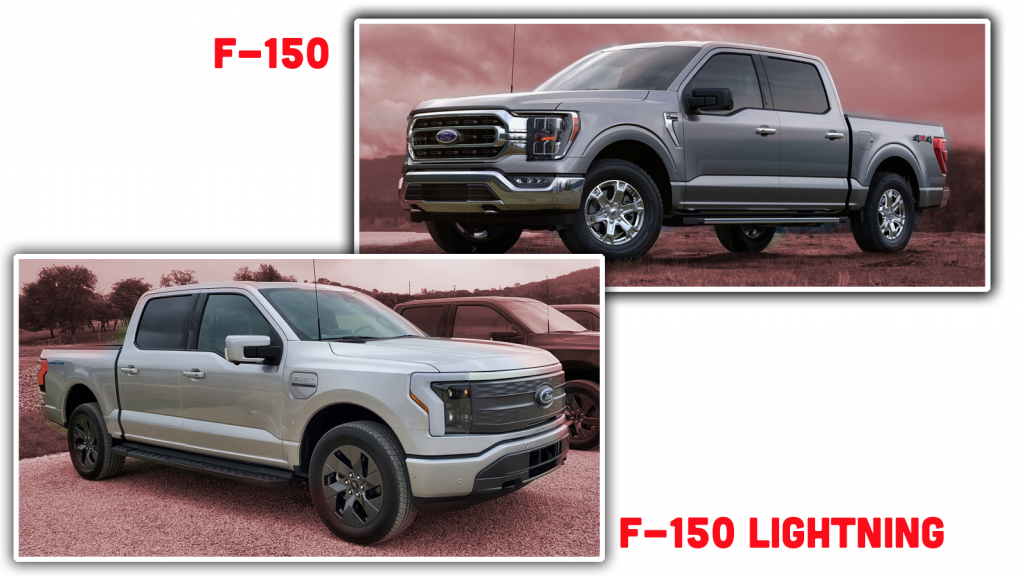

Let’s look at the F-150 Lightning’s aluminum body. Obviously, it looks remarkably similar to that of a standard gasoline F-150, and that’s because it is similar. One of the key enablers that allowed Ford to keep the Lightning’s cost down (the truck starts at around $40,000 with the standard battery and $50,000 with the extended range battery, which is dirt cheap for an EV its size), and to get the vehicle to market so quickly was component sharing. And of all shared parts between the regular F-150 and the Lightning, the biggest ones are cab, bed, and doors.
Still, despite the shared cab structure, inner box structure, and side closures, much of the Lightning’s outer sheetmetal does set itself apart from the standard truck’s. The front fenders, for example, are different; they have charging ports (okay, technically only the one on the driver’s side is real), and the gas truck’s strong arc-shaped crease above the wheel openings is gone, replaced with a large “wheel arch flat” that smoothly transitions into the fender.

The rear “box outer” panels share a similar difference: The gas truck has a sharp character line above the wheel opening, the Lightning does not; you’ll also notice that the provisions for the taillights aren’t the same, as the lights are different shapes. Plus the shape of the top of that outer box panel appears to be fairly plain on the gas truck, whereas the Lightning features a sharp horizontal line that almost gives off a “widebody” vibe. And, of course, the Lightning’s “box outer” no longer features a fuel door.
The Frunk
The Lightning’s hood and front fascia are not the same as those on the standard truck, and there are a number of other styling distinctions that Ford added to its first-ever full-size EV truck, but the main point is that the body’s main structural bits are shared between the gas F-150 and the all-electric Lightning, and that includes the hydroform rails under the hood. That’s these things:


Here’s a closer look at the passenger’s side hydroform rail:

So you get the idea: The Lightning uses a regular F-150 body, but reskins it, and as you can see in the image above, uses the void created by removing a giant internal combustion engine to create what the company calls the “Mega Power Frunk,” a storage area with an absurd 400 liter, 400 pound capacity. It’s awesome.
Ford did a nice job moving stuff out of the way to clear out all of that volume. I’ll get to the electric powertrain packaging setup in a moment, but for now, I’ll just show you some of the bits the company’s packaging engineers jammed around that frunk, behind those plastic panels that I removed, whose clips I accidentally dropped down into the dark abyss (Ford, using two-piece clips for the panels around the frunk was not the move).


For one, the 12-volt battery sits in the center, just behind the frunk, and can be accessed via the panel shown above. On the driver’s side under the plastic trim that I removed is a brake fluid reservoir, what looks like an ABS brake pump, a coolant bottle, and — hooked to that bottle — what appears to be an emergency release for the charging port,

On the passenger’s side is the windshield washer fluid bottle (whose lid pokes out through the plastic trim I removed), an AC refrigerant fill port, and what looks like a fuse box:


Just behind the frunk, right up against the firewall (you can see the indent meant for a transmission on the ICE truck) you’ll see a bunch of electrical connectors, coolant and refrigerant hoses/lines, and — on the left in the image below — a PTC heater. This is basically just a resistive heater (which works similarly to the coils on your stove) that warms up liquid coolant, which flows into a traditional heater core under your dash to warm up the cabin:
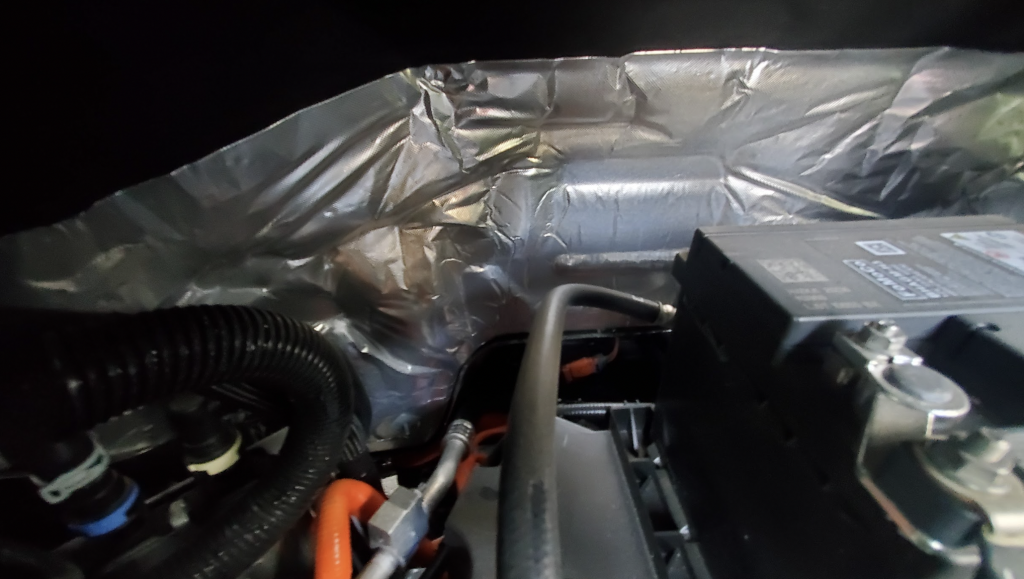
Here’s a closer look:

This is an old-school “legacy” heating setup that basically replaces an internal combustion engine (which is the typical source of cabin heat). The setup is a bit heavy and not particularly efficient compared to a heater core with resistance elements built in (eliminating the need for heavy coolant or any pumping action) and especially compared to a heat pump system, though the PTC will likely work well under extreme conditions and it’s fairly easy to adapt to the F-150’s current under-dash setup. So it’s not surprising to see it here.


The Cooling System
Also behind the frunk, as shown above, was a plate-style heat exchanger and a bunch of other hoses and pipes; I will admit that I didn’t have a chance to talk with Ford’s engineers about the Lightning’s cooling system, so I won’t discuss it much. I will say that I love what I saw in the vehicle’s lower front cooling opening:

Look at that nearly flat-mounted heat exchanger up front. It’s set up that way to allow for decent cooling capacity (the heat exchanger isn’t that small) while reducing aerodynamic drag, because instead of air flowing in and just bouncing around an aerodynamically-challenged engine bay, as is a common practice with most gas cars, the air is ejected out of the holes in the bottom of the truck. As a former cooling system engineer who hated “cooling drag” and how pressure buildup inside an engine bay tended to limit airflow to my heat exchangers, I’ve always considered the ducted cooling module my dream setup. Less drag, better airflow — what more could you want?


Anyway, enough about the body and frunk and cooling system, let’s check out the chassis.
The Frame And Suspension

The image above shows the Ford F-150 Lightning’s frame all loaded-up with its humongous 131 kWh battery, as well as powertrain and drivetrain components. Given that this frame carries the same cab and box as the gas F-150, it should be obvious that the two share body mount locations as well as a number of other dimensions , especially up front.

Ford really didn’t have much reason to change the front of the F-150’s frame, and quite a few reasons not to — the big ones being that the standard F-150 already had a suspension and steering setup that Ford believes satisfies its customers’ needs, and that the crash structure up front has already been optimized for tests like the grueling Small Overlap Rigid Barrier (SORB) assessment run by the Insurance Institute for Highway Safety. You can see that the provisions the standard F-150 has in place to pass SORB exist on the Lightning as well (pointed out with arrows two pictures down).


A Ford spokesperson told me a bit more about the commonality in the front structures between gas F-150 and Lightning, saying over email about crash optimization:
The frame in front is actually similar to the gas F-150. We have high strength steel on the side rails to compensate for the battery package. Most of the optimization was on the side, rear and mid sections. The frunk was also designed specifically with crash deliverables in mind. The team modified the front to accommodate the frunk and motors while keeping key features like SORB (small offset rigid barriers) near the front wheel location intact.

If you’re curious, here’s a look at the F-150 Lightning’s front suspension:



And here are some photos I creepily snapped of some random person’s gas F-150:


The rear part of the F-150 Lightning is where things get really interesting, because it’s a humongous departure from the gas F-150. Here’s what you’d normally find between the rear wheels of an F-150 — a solid axle:

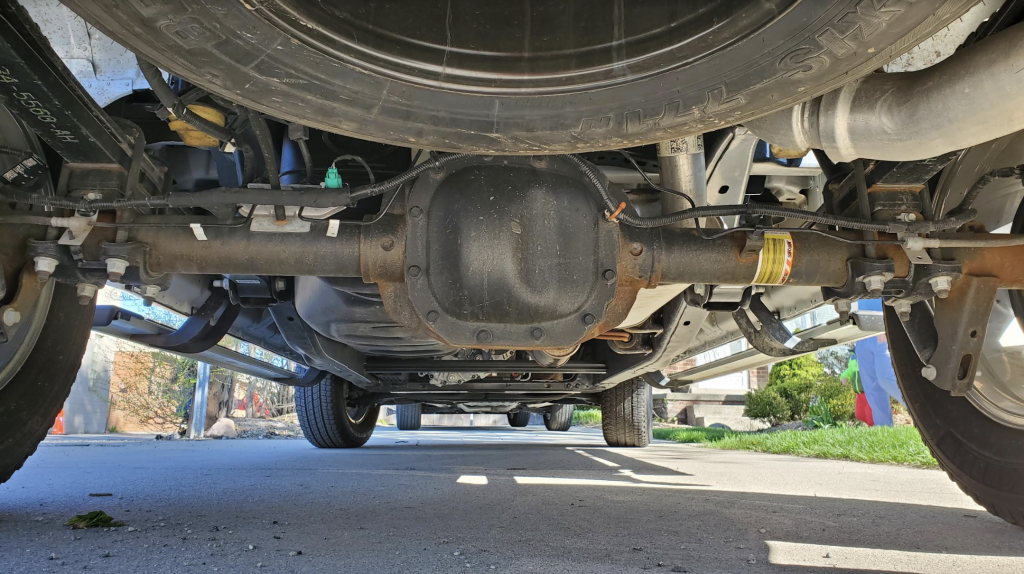
Solid axles aren’t really feasible for electric vehicles for reasons that our resident suspension engineer Huibert Mees explained in an article a few weeks back. The main factors are: Solid axles require driveshafts, which take up valuable battery space; solid axles with integrated motors are too heavy, and unsprung mass is bad for vehicle dynamics; and there are relatively significant losses associated with the power transfer in the differential of a solid axle.
So it only made sense that Ford developed a brand new independent suspension setup, and my god is it glorious. Here’s the look under the F-150 Lightning from the rear:




The axle is gone, as are the old-school leaf springs; in their places are a semi-trailing arm independent rear suspension and coilovers. Both changes are considered fairly massive improvements in terms of ride and handling — the reduced unsprung weight makes it easier to fine-tune the truck to optimize both.


The first thing you notice when looking at the rear suspension is the sheer size of the control arms; they’re unbelievable:


Look at how huge the casting is! Check out how tiny my hand looks in relation!:
This new suspension was probably a major investment on Ford’s part, but unquestionably the right call over trying to make a solid axle work.
The Battery

Let’s look at the center section of the frame — particularly the bit that holds the battery — and compare it to this center bit of the gas F-150’s frame:


One thing Ford made clear is that its team reinforced the hell out of the rails in this wheelbase-area as a way to protect the battery from side impact crashes. I believe it; the fully-boxed frame is seriously beefy.

The liquid-cooled battery pack is made up of enough pouch cells to yield 92 kWh of usable capacity in the standard-range models or 131 kWh of usable capacity in extended-range models.
The way the pack is mounted between those frame rails is quite interesting. The big battery is actually bolted to a large steel, structural ladder-shaped subframe (you’ll notice fewer crossmembers than on the gas truck, presumably because this subframe is stiffening things up), with rubber isolators between the pack and the ladder. The isolators should protect the battery from major shock loads that enter the frame; other benefits of those mounts may have to do with allowing frame flex, and there may also be NVH-related advantages involving harmonics, though I’ll update this article when I get word from Ford on its main considerations when choosing to isolate that battery. Anyway, here’s a closer look at the battery’s ladder subframe:


Here’s a closer look at how the ladder subframe mounts to the truck:

And here’s an up-close of some rubber isolators between the subframe and battery pack:


Honestly, it seems like battery removal for servicing wouldn’t be too difficult. There are some high-voltage plugs in the front shown below in orange, and there are some coolant inlet ports (in red) — and I assume the same plugs are at the back of the battery, connecting it to the rear drive unit — but otherwise it appears to be eight bolts and the battery pack (along with its subframe) are coming straight down.

[Editor’s Note: I think this easy battery removal will prove to be a very big deal as these trucks age and end up on the used market. Not requiring major surgery to swap batteries is fantastic, and I’ll be curious to see if a remanufactured/third-party F-150 Lightning battery ecosystem develops. – JT]
The Powertrain

All Ford F-150 Lightnings are all-wheel drive, at least for now. They feature the same three-phase permanent magnet AC motor at the front and rear, packaged between the frame rails and bolted to a roughly 9.65-to-one gear reduction. I say “roughly,” because, per a Ford engineer, the two gearboxes actually have slightly different gear ratios as a way to quell concerns related to harmonics. “Why even put yourself in that situation?” the engineer asked me, saying there’s no downside in having one motor run at a slightly different RPM than the other; this can make a difference in ensuring that the two motors don’t constructively interfere and create a Noise, Vibration, Harshness issue. (Incidentally, that same engineer told me that, during highway cruising, Ford found that running a 50/50 torque split between front and rear motors was most advantageous).

Here’s a look at those motors’ guts:


Here’s the motor controller that’s integrated into each drive unit. Its job is to make sure the motor does what the driver tells it to do (accelerate, regen, go in reverse, etc):


The gearboxes, by the way, are axial/planetary types, meaning the motor is parallel to the output shafts (one axle goes through the center of the motor). That’s why you can see that both motors are right in line with the axles (Teslas tend to have the motors offset with the gearbox output, so the Motor is either in front of or behind the axle).
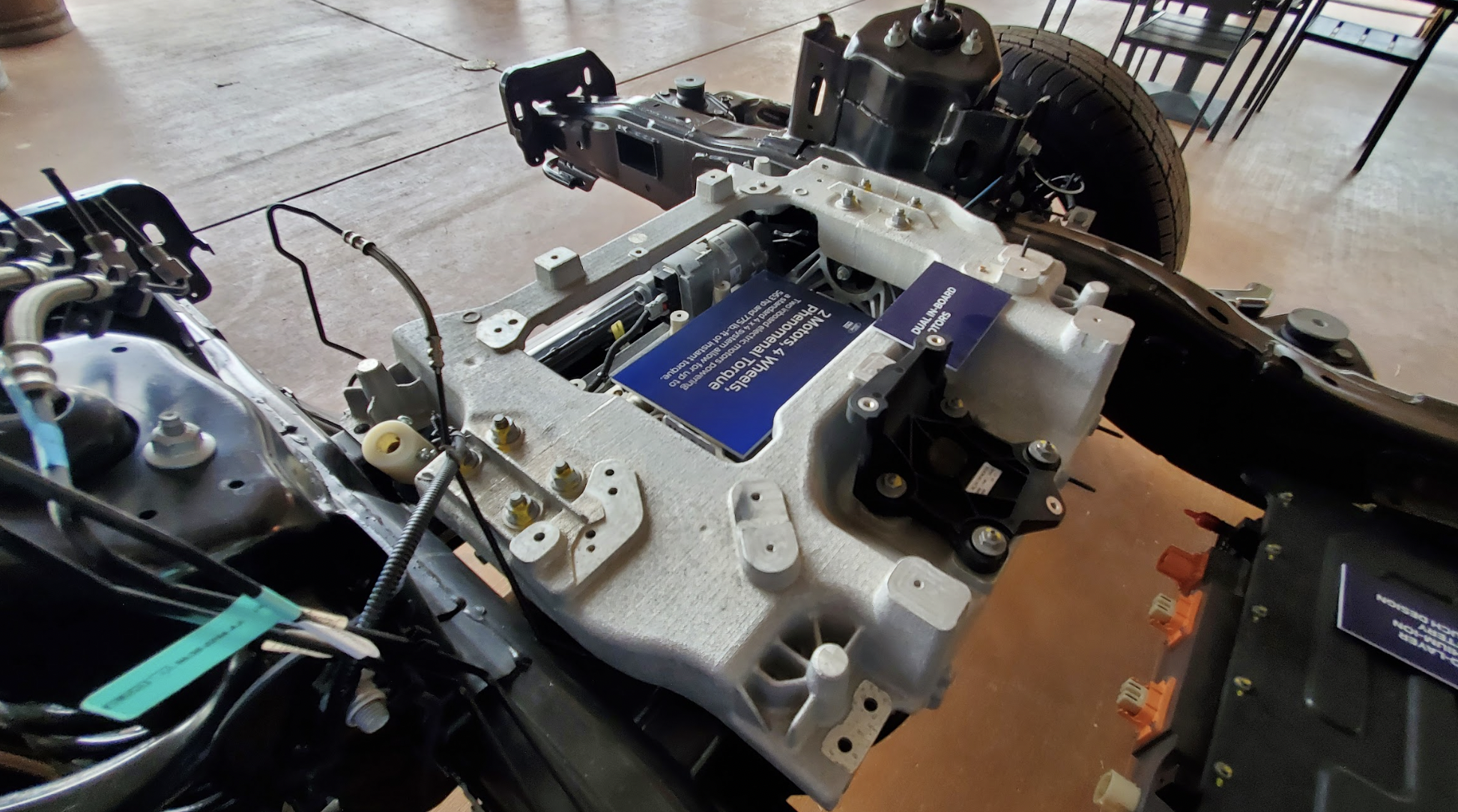
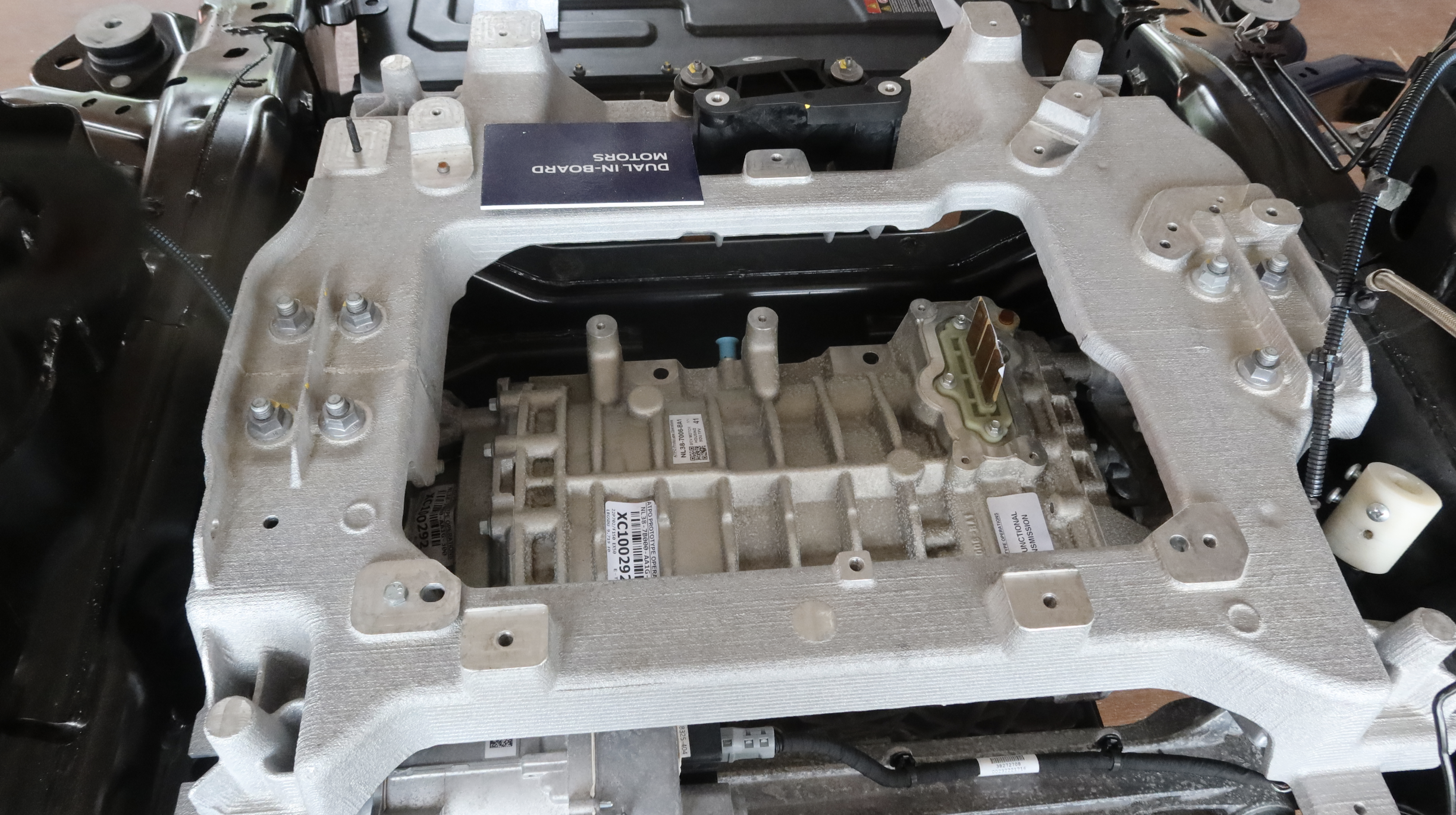
Let’s have a quick look at that front motor. It hangs from a cast aluminum bracket that’s bolted to the frame. It has a bunch of provisions for, presumably, an inverter and power electronics, and you can see that in the rear there’s a black bracket for one of two high-voltage AC compressors (Ford says it uses two to feed chillers for optimal thermal performance in high-load, high ambient temperature situations).
Here’s a closer look at how that front drive unit hangs off that cast aluminum subframe — you can see round rubber mounts:

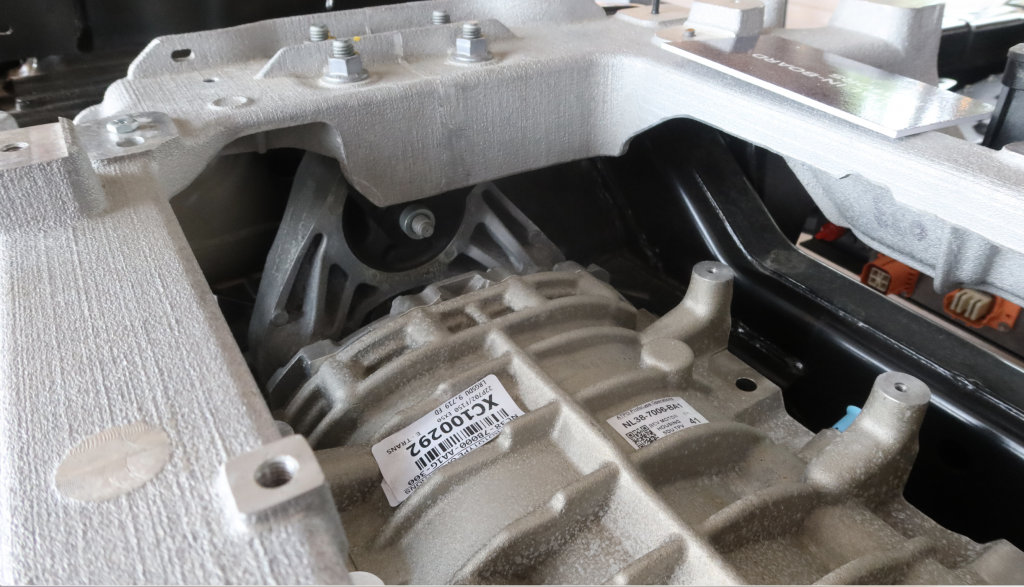

Of course, with just two mounts, as soon as you’d hit the accelerator pedal, that motor would just spin about its axis, so here are the two additional torque mounts. They’re two dogbone-shaped links that tie the drive unit to a front frame crossmember (which is different from the gas truck!), which is also where one of the front suspension control arm mounts ties into (also: notice the plate-style heat exchanger on the drive unit):

While we’re on the topic of crossmembers, it’s clear that Ford is making the most of them. The rear drive unit also shares a mounting location with the humongous control arms. Here’s a look at the rear drive unit, which you can see clearly along the same axis as the rear wheels:


Here’s a zoomed-out view of that shared crossmember, which I’m going to now dub the Mega Power Crossmember:

Here are the motor mounts. up close:
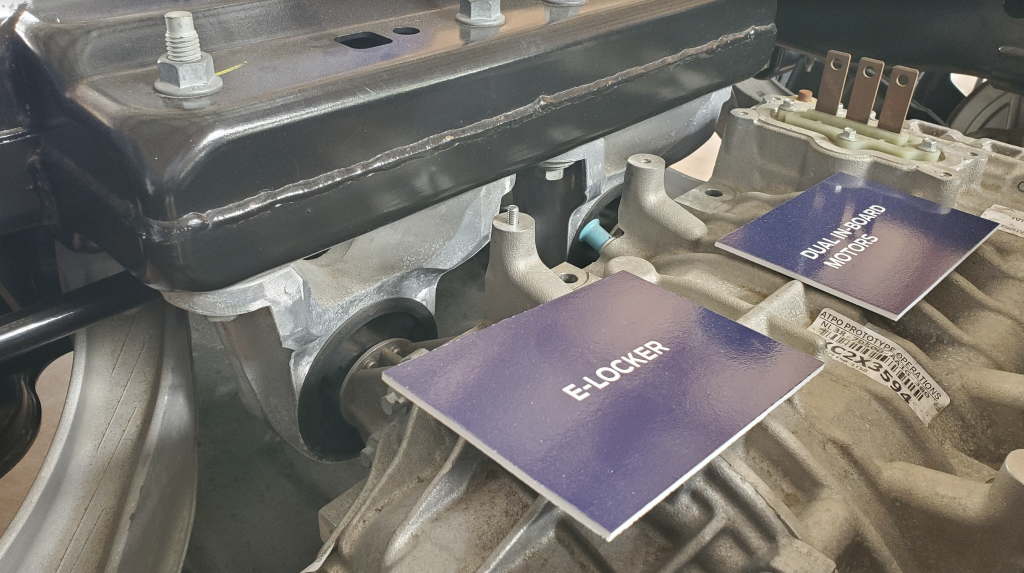

And here you can see where those massive control arms tie into that same crossmember (and like on the front drive unit, you can see a plate style heat exchange bolted onto the rear unit):


The rear motor has two additional mounts — at the two brackets that point straight down from the frame on either side of the spare tire:




Anyway, I could spend another 5 million days writing about this truck’s hardware, so I’ll stop and ask you to watch the video below so I can get to the subjective stuff.
What’s It Like To Drive?
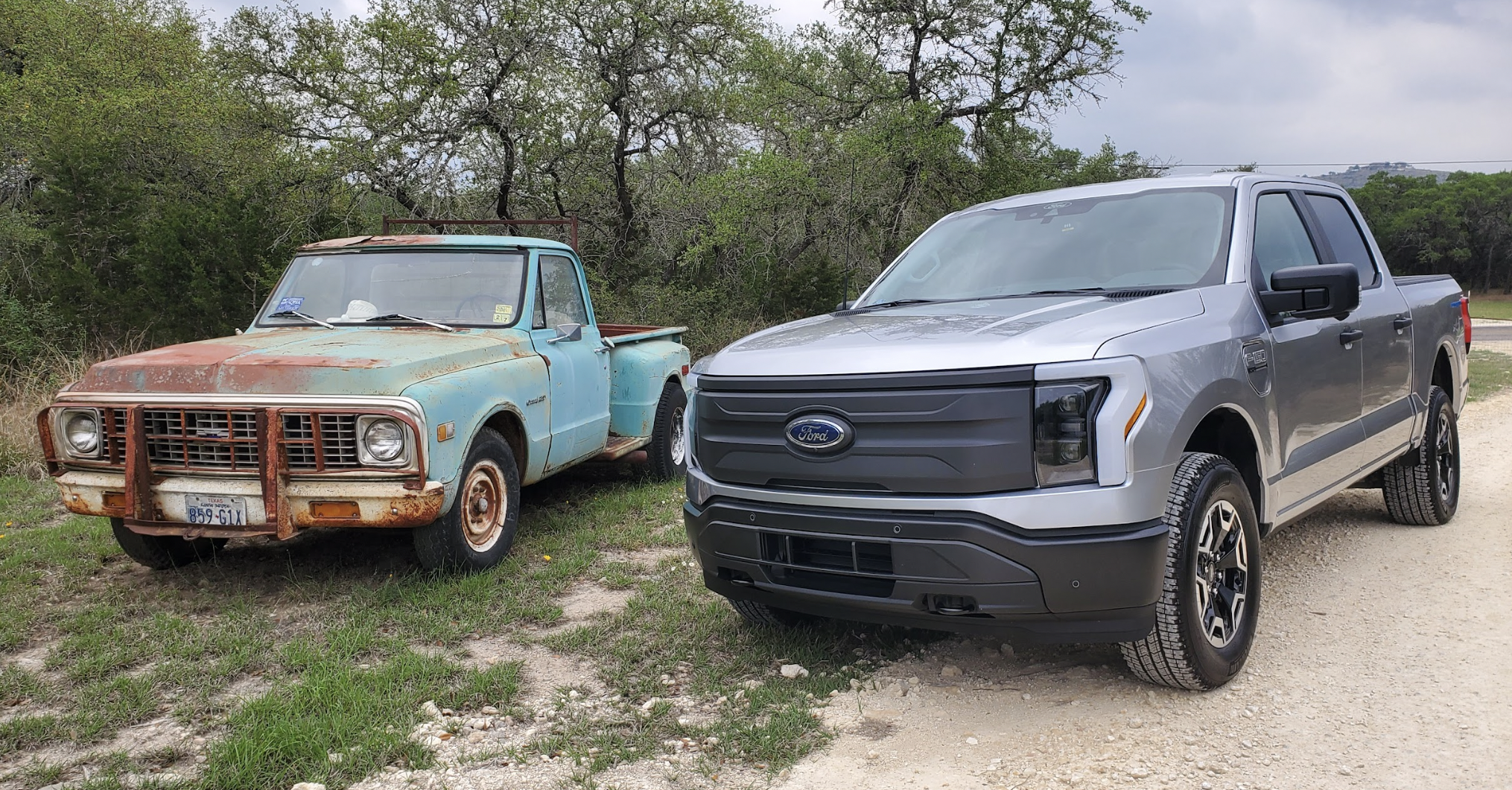

The first F-150 Lightning I drove was a $56,100 base “Pro” model with the extended range battery that promises 320 miles of range (the smaller pack offers 230, per the EPA). This is a fairly basic truck, with vinyl floors, synthetic leather seats, and an interior devoid of too many frills.
The Cabin Looks Familiar, Sounds Anything But

Everything about the cabin feels like a regular F-150, and that’s because the Lightning shares the gas truck’s interior; it even shares bits you wouldn’t expect it to share, like the chunky T-handle shifter, which is a far cry from the dainty “shifters” one tends to find in other electric vehicles.
Ford’s parts sharing, especially here in the interior, is a brilliant strategy, and not just for the obvious “It saves cost” reason, but because it offers truck buyers familiarity. The reality is that there’s still a bit of a hump that traditional pickup truck customers need to get over before they’re fully onboard the electruck train; to offer them a vehicle that looks and feels like an F-150, but introduces the many benefits of an electric powertrain is a great way to transition the masses to the new technology without shocking them with too much gadgetry.
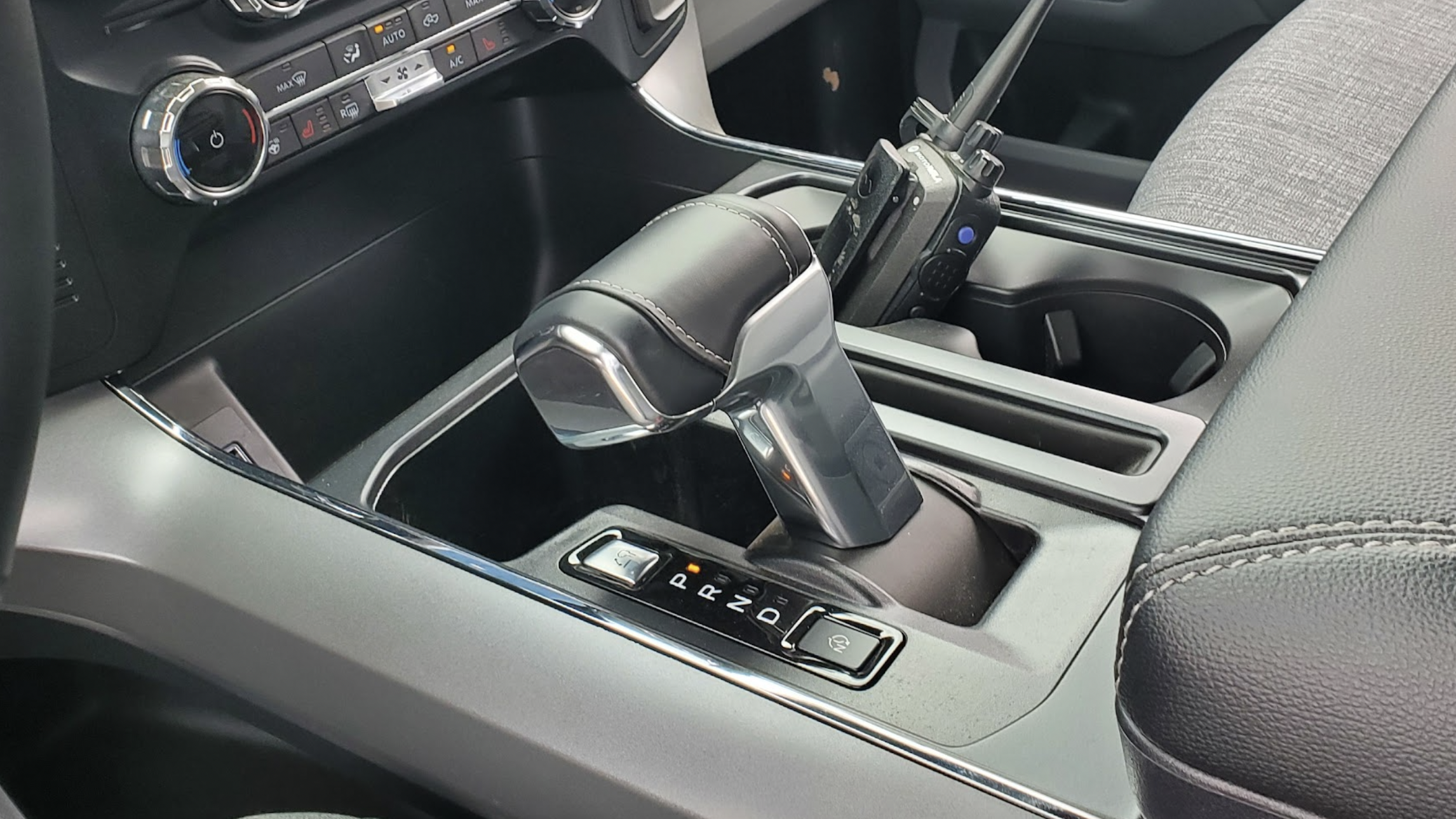

The F-150 offers truck buyers the chance to head to a dealership and drive a gas and electric version of essentially the same truck, so they can really see the differences that EV technology offers in terms of performance. And that, I think, is going to go a long way to convincing truck buyers that EVs are worth their money.
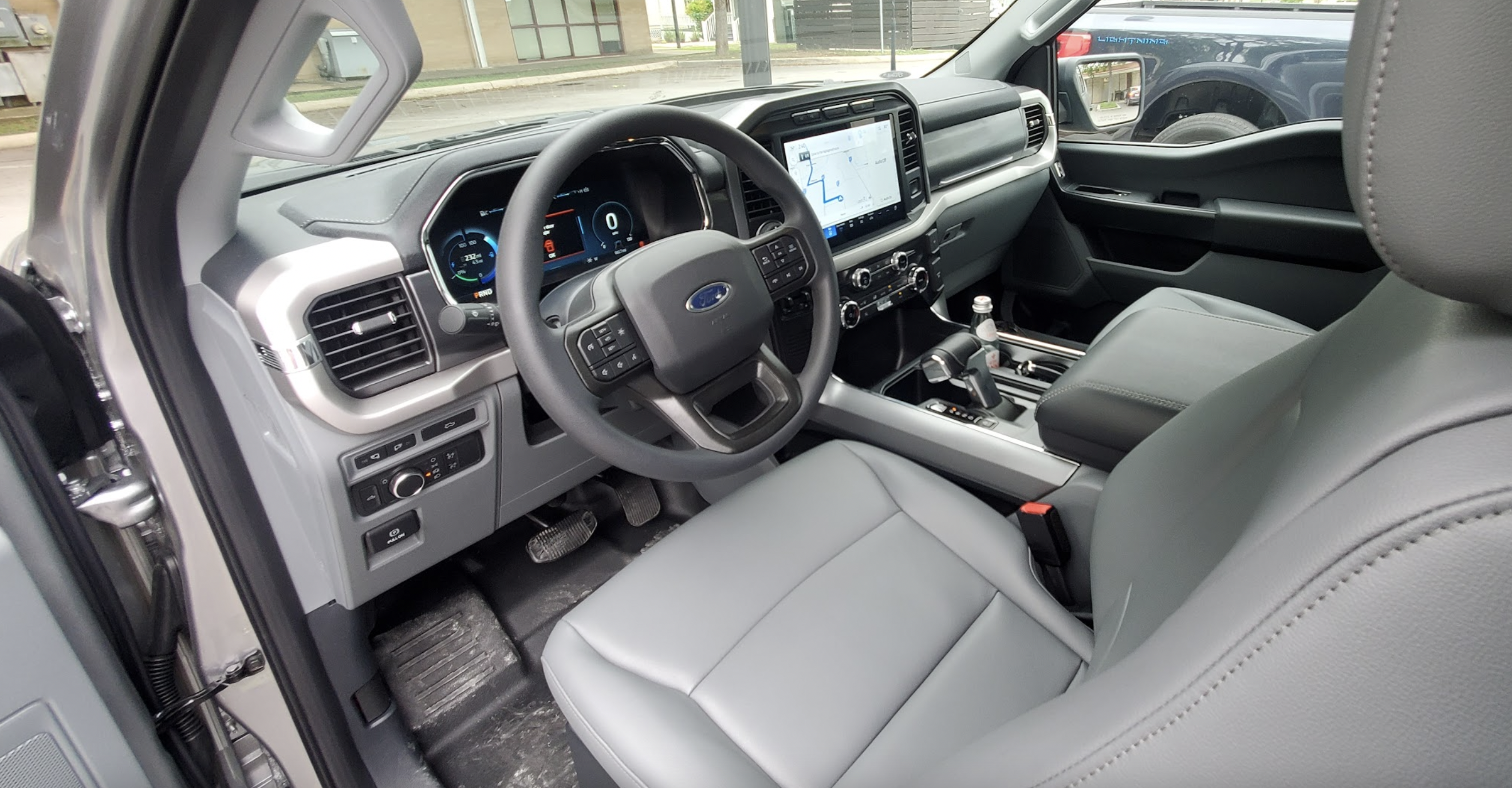
Hopping into the truck, I clicked the “start” button, and shoved that satisfying shifter into “D,” before pressing the accelerator pedal and quietly inching the big, heavy pickup through downtown San Antonio towards the freeway. When I got there, one thing became abundantly clear: The Ford F-150 Lightning may be the quietest vehicle I’ve ever driven. It is absurd how well-isolated that cabin is from tire noise, wind noise, neighboring car-serpentine-belt-squeal noise, you name it — the inside of the truck is a borderline sensory deprivation chamber, with aero noises only making themselves even worth noticing at speeds above 70 MPH, and road noise really the only noticeable audio signal to your brain during most driving.
My lack of sleep the night before, combined with the quiet cabin, led me to pull over and actually go to sleep in the middle of my test drive. Which I’ll remind you, is my job. The F-150 Lightning forced me to sleep on the job. My reputation is in jeopardy.


Lariat and Platinum models get a Lightning-Exclusive 15.5-inch infotainment screen and some other changes to the interior, so for those of you not interested in those vinyl seats and floors, here’s a nice dashboard to go along with your fancy Latte:

On the fancier trucks, you can also get “BlueCruise,” a feature that allows for hands-free driving, though you have to be ready to take over. I’m not a huge fan, since I think I may as well hold the wheel if I might have to jump in any moment anyway, but — despite a few hiccups — I will say that the system allowed me to drive on a nicely-marked freeway for roughly 15 minutes without me having to provide input. Perhaps over time I’d have appreciated that.
Acceleration, Ride and Handling

The Ford F-150 Lightning that I drove makes 580 horsepower and nearly 800 lb-ft of torque. The thing, as shown in the video above, is an absolute slingshot, with full-pedal applications forcing my head hard against the headrest as the vehicle rocketed to 60 mph in not much more than four seconds. Like most EVs, the Lightning responds to input with immediate and unrelenting fury beyond what most have probably ever experienced in any pickup truck. Dodge Ram SRT-10 be damned.
The Lightning’s ride quality is great. The suspension never feels jittery or harsh; it’s confident and stable. I can’t tell you how much better the ride is compared to the solid axle-and-leaf spring-equipped gas truck because I daily-drive old junkers, so my butt-sensors are all sorts of out of whack. (I find the gas F-150 to ride beautifully, too). Still, there was no head-toss where I might have expected it on the solid-axle truck, particularly when hitting bumps in turns.
Speaking of the turns, I did not approach any at speeds that I’d consider even remotely “high” (hell, or even “moderate”). Despite its near-50:50 weight distribution, this is a pickup truck, not a sports car, and I’m not trying to die. Is this truck heavy at over 6,500 pounds? Yes. Could I feel that in the turns? Sure. But lots of trucks are heavy, and I found the Lightning’s handling to be just fine, with the truck having some body roll, but less than I expected.
It Tows Like A Boss, But Prepare For Torque Steer

A number of you likely want to know what the F-150 is like when it comes to towing and especially towing range. And while I can’t answer those fully, I did have a chance to tow a 4,500 pound airstream for about a half an hour, and I took a peek at a bunch of different trucks to see how much range they expected when hooked up to certain trailers.

First, I’ll discuss towing performance. The truck above handled that Airstream like an absolute boss. I’ve done a lot of towing in my life, usually involving broken cars on U-Hauls, and no towing that I’ve ever done was remotely similar to what I experienced in the Lightning. Usually when you’ve got 4,500 pounds hooked to your hitch, you adjust your driving style. If you merge onto a highway, you might look especially far back in that side mirror to make sure nobody’s within’ at least two counties of what will be a glacially slow acceleration to highway speeds.
But in the Lightning, that’s just not an issue. The output of those motors is so prodigious that, even with a trailer hooked up, stomping on the accelerator pedal yielded instant, and downright impressive acceleration. I think the truck, even with a 4,500 pound trailer, could do zero to 60 mph in under seven seconds. That’s just a guess I pulled out of thin air, but the mere fact that I’m predicting anything below 10 seconds should tell you how absurdly responsive the truck is while towing.
[Editor’s Note: I’d like to point out that the dash display in this video is interestingly minimal; David told me it’s a special “calm” mode, perfect if you’re someone who hates overstimulation. Personally, I like my display to look like the bridge of a spaceship, but I get the appeal. – JT]
One thing I should mention is torque steer — the tendency of a vehicle to turn on its own under acceleration. On the Lightning, particularly when loaded up and when the driver is heavy on the pedal, torque steer is pronounced. While towing, if I stomped on the pedal, the wheel would want to jerk counter-clockwise. Keen to avoid the oncoming lane, I naturally made a steering correction, which led the traction control system to send power to the opposite wheel, leading me to again make a correction, which sent power to the other wheel on the front axle, and on and on.

Too much pedal would sometimes got me into a cycle where the truck would lose grip on one front wheel, torque-steer, I would correct, power would transfer to the other side, which would lose grip, I’d get more torque steer and make more corrections, and the whole thing was just bizarre — I’m hacking away at this wheel as the truck is chirping the left tire, then the right, then the left, then the right.
Obviously, heavy throttle while towing is a fairly narrow use case, but I noticed the issue even while accelerating out of turns — one tire would chirp, torque steer would join the party, I’d try to boot torque steer out of the front door, and then it’d just come right back in the back door, and it was all just a bit odd.
Also relevant when towing is the tow-vehicle’s weight. A fully-loaded F-150 Lightning comes in at around 7,000 pounds. And while this isn’t ideal for handling and efficiency, it could be advantageous in terms of towing stability. I haven’t spent enough time towing with the Lightning or the gas truck, but I will say that yanking the trailer with the Lightning was one of the least stressful towing experiences of my life, and I was on twisty, unfamiliar roads. (Well, I should say: unless I pressed the pedal too hard).
Towing Range

[Editor’s Note: David says the “How To Talk To Girls” was a song, not a self-help audiobook, and it was on the truck and he didn’t pick it so no judgments. – JT]

Let’s talk about range.
At the media event, a Ford engineer told journalists that he found that “the impact [of towing] on range in an electric vehicle is basically the same as the impact on range in a gas vehicle.” So if you’re used to 22 MPG highway on your unladen F-150, and you typically get 11 MPG highway while towing a given trailer, you might expect to lose about 50 percent of your range when towing that trailer on an F-150 Lightning.
Obviously, this is possibly the least scientific answer to the towing range question, but I appreciate Ford even providing a general guess, since there are so many factors that play into towing range, including trailer shape, trailer size, ambient conditions, driving style, etc.
Keen to see if I can get another indication of how many miles one might expect from the battery while towing, I looked inside a bunch of trucks that were towing loads to see what the indicated expected range was.


The way the F-150 Lightning predicts towing range involves making an initial guess based on inputs from the user — things like dimensions of the trailer, trailer shape, and trailer weight. After that initial guess, the truck refines its range estimate based on driving history. The trucks at the press event had been driven on the same route numerous times, so they should have had a chance to make reasonable range estimates. So let’s look at a few readouts starting with the one above in my tow truck.
My truck, with its 4,500 pound trailer, estimated a remaining range of 144 miles based on a 93 percent battery capacity. Assuming a linear relationship between range and battery percentage (which is fine for a back-of-napkin calc like this one), my truck should manage 155 miles of range, or just about half of the unladen range.

The truck above towing the 5,000 pound horse trailer showed an estimated range of 138 miles, with a remaining battery percentage of 87 percent, equating to a range of about 160 miles.
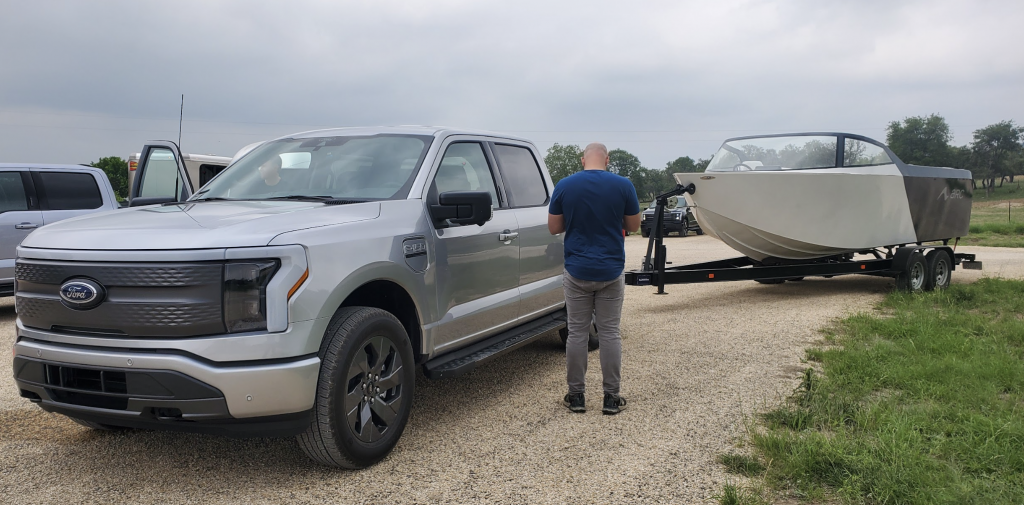

The less-boxy boat above weighs 8,300 pounds, and the truck’s screen said it had 135 miles left based on 88 percent battery state of charge. So at full battery capacity, the truck should go 153 miles.

The truck above towing a 5,000 pound horse trailer said on its screen that at 81 percent, its battery could get the truck 128 miles. That’s about 158 miles if the battery were full.

The truck carrying the heaviest load is this black one. It showed 61 percent battery capacity remaining with an estimated range of 90 miles. Ninety miles divided by 0.61 is about 148 miles. Note that the truck showed an efficiency of 1.1 miles per kWh.


I want to make it clear that these are just estimates, and that none of these trucks were driving at highway speeds, plus I don’t really know how much driving data the trucks had to base these figures off of, but in a world where people seem endlessly curious about how well and how far electric vehicles can tow, I figured this would be better than nothing. I’ve included Ford’s claimed charging times above, so you can get an idea of how long it’d take to get another 150-or-so miles out of your tow rig.
Off-Road
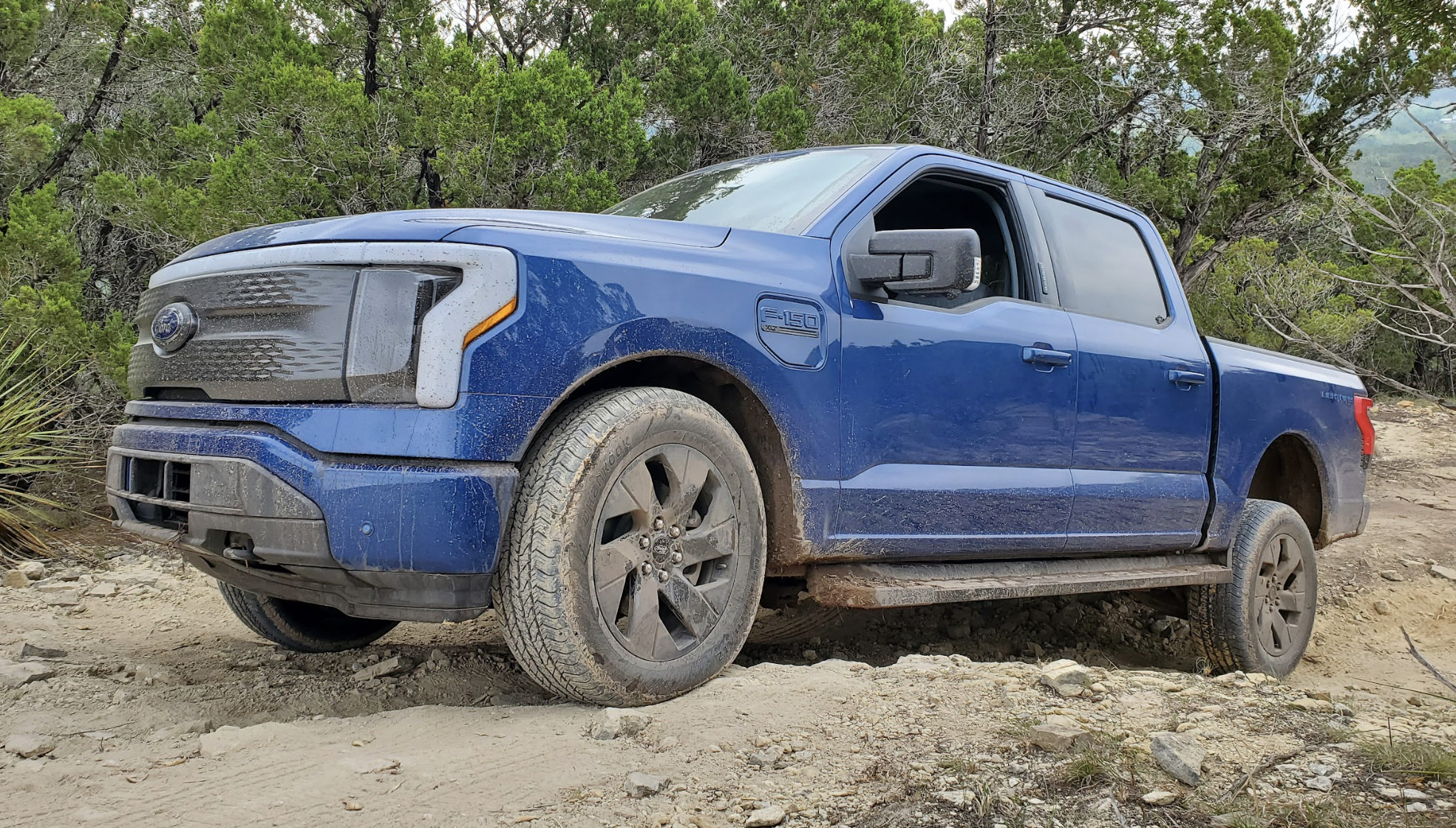
The Ford F-150 Lightning is not an off-road vehicle, but it is a pickup truck, and with that classification come certain expectations.
I took the Lightning off-road on a fairly mild course in San Antonio, and had a chance to climb up some hills and bomb through some mud pits. The truck did very well. The standard locking rear differential — activated with a press of a button on the touchscreen — mechanically connects the two rear tires together, and provides a significant traction advantage. Up front is an open differential, though a brake-based traction control system (often called a Brake Lock Differential) does a decent job apportioning power to the wheel with grip.


Obviously, with the solid rear axle gone, overall suspension flex is down over the gas truck, but honestly, the rear suspension travel is not insignificant:




When one tire does lift off, you’ll be glad you have that rear locker to make sure power gets to the ground. 
I have to give some credit to whoever did the pedal calibration for the truck. When in off-road mode (which you select on the touchscreen), I found it easy to precisely modulate the truck’s speed when climbing steep grades. In many trucks, I tend to surge over the tops of hills, or I have to keep my foot on the brake pedal to keep speeds down, but with the F-150 Lightning, I could climb grades incredibly slowly while having only my right foot on a pedal.
In lower load scenarios (i.e. not climbing steep grades, maybe going over a log), I found that it was a little harder to modulate speed. The truck tended to want to go faster than I wanted, so I did find myself using left-foot braking. This is an instance where I’d have liked at least the option of one-pedal drive mode, which is only available outside of the off-road drive mode. One-pedal drive basically slows the vehicle to a stop unless the driver is on the accelerator pedal, so it’d help in scenarios where one wants to avoid gaining too much speed, such as when traveling downhill.

In fact, there is no hill descent control at all on the Lightning — you just have to ride the brake. This isn’t a huge deal, since the brake pedal “blends” regenerative braking with friction braking, but it’d still be a bit nicer to have the machine keep you under control so that it’s not just your right foot preventing you from careening down a hill at 30 mph. It’s a little unnerving, especially as someone with lots of off-road experience who’s used to using low-range gearing and engine braking to keep speeds under control.

Ford did offer an explanation for the lack of one-pedal driving in off-road mode: Basically, one-pedal driving mode pretty much sacrifices some amount of pedal travel — say, 20 percent. So if you’re not pressing the pedal 20 percent, you’re decelerating. “That means you’ve taken away 20 percent of your pedal travel from your acceleration ranges, so that’s less fidelity that we can give you for power application.”
Hmm.
In either case, on a vehicle like the Lightning, which really isn’t meant for hard-core off-roading, I think Ford made some smart decisions, as the vehicle is capable enough despite its geometry, which is rather limiting.


The ground clearance wasn’t too bad, but that low-slung battery, along with the long wheelbase, meant that battery subframe rubbed while I was off-road. I anticipate breakover angle being the biggest limitations to the truck’s capabilities, which again, are more than adequate.
Update: One thing I forgot to mention was that I heard quite a bit of “clicking” while off-road, especially in low-traction situations like the mud pit. The clicking was unlike anything I’d heard from any conventional ABS pump, so I wasn’t sure what was going on. It sounded like relays. Well, a friend of mine reached out and mentioned the brake parts I showed in my underhood photos, saying he sees a “one box” braking system with combined booster, master cylinder, and ABS controller (this single system decides how to decelerate the truck by choosing how to blend regen and hydraulic braking). “If you’re on ice you’ll be able to hear all the clicks and clacks,” he told me of such a setup. And that reminded me of the clicks and clacks I heard in that mudpit. Anyway, the point is: You hear braking clicks while off-roading the Lightning. It’s no big deal.
Conclusion

I mentioned in my introduction that electric cars built on gasoline platforms tend to be highly compromised machines. Vehicles like the VW e-Golf and the electric Mini come to mind. These cars are built on unibody platforms that, by their very nature, are shaped in a precise way that optimizes packaging efficiency for a gas vehicle. The unibodies not only integrate the vehicle’s structure, but they also envelop major components like the gas tank, exhaust, and driveshafts. The bodies are literally purpose-designed for gasoline powertrains.
Fitting a big flat battery pack under the decidedly-not-flat body of a car specifically built with provisions for ICE components just doesn’t work well.; The vehicles tend to fit too few batteries, or those batteries are in a weird location, and the end product tends to weigh too much (since the battery wasn’t integrated into the body’s structure in the first place).

Things are different with a body-on-frame machine. If you look at how a truck is built at a plant, you’ll see that the frame acts sort of like a Tesla “skateboard” in that it contains the suspension, and the main drivetrain and powertrain components are mounted to it. A body sits on top.

A body-on-frame setup lends itself well to electrification, since there’s so much space between the rails. Unibody proponents have said that this is wasted space, and part of the reason why body-on-frame vehicles tend to have taller floors and less interior volume, but for the purpose of electrification, this “wasted space” is actually quite welcome. Ford was able to clear out enough stuff from between its frame rails to fit a humongous battery, as well as a complete, high-performance electric drivetrain — all with zero compromises to interior volume. In fact, the frunk actually increases overall volume.

Of course, there are compromises associated with going this route. Mounting a 1,600 pound battery on a heavy ladder frame, and not using the battery as part of the vehicle’s structure doesn’t seem like the best way to keep weight down, and if I had to guess, the truck could have been better optimized for aerodynamics had it not used the same cab as the gas truck.

Speaking of integrating the battery, I think a ground-up new platform likely would have tucked that thing up a bit. As it sits, the battery hangs down below the rockers in a way that’s not particularly aesthetically pleasing, adding a bit of bulk to the side profile:

Side steps help with that:

Anyway, I mention all of this because engineering is literally the art of compromising. And when I look at the Ford F-150 Lightning, all I can see is brilliant engineering from a company that can’t seem to miss right now. The few compromises I just mentioned were clearly, without question, the right ones to make in order to share enough components to allow Ford to build the first mainstream full-size electric truck in U.S. history quickly, in a price range that appeals to consumers, and in a way that should maximize quality (since many of the components have already been vetted) — and also to execute it all well. And Ford has. This truck is quick, it rides great, its EPA-rated range is solid, it’s unbelievably quiet, and above all — it’s familiar.

And that last point, as I’ve said before, has the potential to shift America towards electrification like no vehicle ever has.





I have *0* interest in trucks. Living in a civilised part of the world has upsides. But I read the whole thing twice. Love the detailed analysis and general nerdiness.
Vielen Dank, Freunde!
David, this has to be one of the most comprehensive new vehicle reviews I’ve ever read. Hats off to you for taking the time to go in depth over this truck’s new technologies along with all the comprehensive photos.
As an aside – bonus points to you on your test drive video for noticing the important things in life. Like, giving a shout out to a freakin C5 Galaxy coming in for a landing. Excellent!!
First off, this was a great review, no other car blog does anything like David did in the first half of the article.
Second, I wonder about this statement:
“The F-150 offers truck buyers the chance to head to a dealership and drive a gas and electric version of essentially the same truck, so they can really see the differences that EV technology offers in terms of performance”
more precisely about how the dealership/sales guy is gonna try his hardest to steer customers away from the Lighning and towards the gas trucks, and whether Ford has got a strategy (training, sales incentives etc) to counter that.
This is only true when you speak exclusively of the bad dealerships and bad salespeople. Period.
A good salesperson at any dealership understands that their job is to get the customer into the car that they want, at a price they can afford, and which they will be happy with. That’s what keeps them coming in the door for service, and that’s what brings them back for their next car. The formula really is that simple.
Take care of the customer, and the customer takes care of you.
If the customer needs a truck TODAY, they have absolutely no choice in the matter. None at all. “We can put you in an F150 with the 3.5 today, or a Lightning in about 3 years time.” They’ve already sold out of 2 years worth of production, and that’s assuming they can double production in the second year. That’s why no dealer in the world can take your F150 Lightning order.
So Ford doesn’t need to provide incentives, and they would in fact, be counter-productive and harmful to the good salespeople. My Ford guy would love to sell me an F150 Lightning. He’d kill to have one to put on the floor. But he can’t sell me one, and pushing me toward one doesn’t help either of us. I don’t get a car, he doesn’t get a sale, and he gets three years of me calling up going “where’s my damn truck?!”
It’s bad for me, bad for him, bad for the dealer, bad for Ford. Just look at how ridiculously pissed off Bronco buyers got over having to wait even when the dealers weren’t trying to upcharge after the fact.
That’s why I keep hammering home this point: unless Ford can ramp production, the F150 Lightning will either be permanently unattainable due to flippers and FOMO idiocy, or will ultimately end up failing because it can’t meet demand. Dealers will not be able to show customers the pros and cons because they can’t get one, and what customers do get one will probably have a very bad taste in their mouth from the flippers.
That was satisfying. This fits about 90% of use cases I see for work trucks, and about 80% of the truck-bro requirements. Sure, some people have a boat, 2 ATVs, and a property 300 miles away… but for the rest, this is close to ‘it’.
We just traded in a 2011 Volt for a Subaru. Why? Because the main battery was dying. The car had about 150,000 miles so we aren’t talking excessive miles here. And at 11 years old it was far from ancient. I loved the car. But the experience I had with the battery has made me sort of back off a bit from EVs. I would REALLY like to replace my now 26 year old Tacoma with a EV truck. The Volt was an early attempt at an electric drivetrain and I assume battery tech has improved. If I knew I could buy the above truck and expect 15-20 years out of the battery then fine. But if that means I’m staring down the barrel of a multi-thousand battery in 10 years? That’s hard to swallow.
As far as the Lightning? I think its the most likely vehicle to finally get middle America to consider EVs. Seemingly everything before has been geared almost entirely to metro Americans. Most conservative/rural folks I’ve met still think EVs are some sort of liberal concept. But if they start seeing what amounts to a F-150 with a battery? Might get them off the fence.
Why can’t more manufacturers figure out that this is the winning formula. Keep all the aspects that work well on a great ICE vehicle and just swap the power train for an EV one and only make the changes that are necessary for that change. No more, no less.
“So if you’re used to 22 MPG highway on your unladen F-150, and you typically get 11 MPG highway while towing a given trailer,”
Maybe this is just a Ford thing, where if you had an ecoboost engine you could expect your mileage to absolutely tank with a trailer. 22 highway, 8 towing. For most gasoline towing I’ve seen 20-40% drops. With turbo engines, I can see well over 50% drop. Enrichment, man, it’s a killer.
They payoff is when you’re not towing, it gets significantly better mileage. My dad has owned F-Series for decades. His 2012 EcoBoost 4×4 SuperCrew will average 20 mpg. Nothing else came close, not even his Inline 6/5spd/reg cab/2wd. Phenomenal compared to a 5.4L and much more usable torque when needed.
So, yes, when you go from 14 to 12, it’s not as big a drop as 22 to 11. It’s all relative to what you’re doing with the truck. They kept the V-8, and even offered a TurboDiesel. People still overwhelmingly prefer the EcoBoost.
The trouble is that Ford’s competitors’ NA offerings are all hitting similar unladen numbers, but their towing numbers don’t fall off a cliff.
My Sierra 3.0 diesel gets the same mileage towing my camper that my 2010 Acura MDX got during normal driving (~18.5 mpg). And it’s easily the smoothest, easiest to drive truck I’ve ever owned.
Does he drive mostly highway? And I bet he drives smooth and smart, then too. 20 mpg really good esp for 4wd supercrew. BR.
If I used a truck to haul a camping trailer a few hundred miles every long weekend, I would stick with gas. But if the only thing I towed was a utility trailer to the dump, or an air compressor to a jobsite, or my boat to the local launch, or my horse to wherever people tow their horses, I would be all over this. And I bet this usage pattern is in the 80-th percentile of F-150s sold. (That is, only 20% have a more demanding usage pattern than this.)
If Ford can ramp production fast enough they’ll have a huge lead in the EV truck space.
This is what I keep thinking… I have a ’95 F150 and a motorcycle. The motorcycle is for road tripping. The F150 is known as the Ranch Wagon (my parents have a little bit of property less than a mile from me), and it’s for hauling brush piles around the property, and trips to Home Depot, and trips to the nursery, and the occasional yard sale, and maybe helping someone move in town. an EV would be BEYOND perfect for how I use that vehicle!! I haven’t thought about buying a new car in a really long time, but this is making me reconsider.
E&E accomplished. Thank you.
Great review. I’m not a huge fan of Ford in general, but they really seem to have gotten an electric pick up to be pretty mainstream.
The word is out (or will be soon): come to The Autopian for the most comprehensive new product reviews anywhere. Wow. Great work, David.
An excellent article, and answers a lot of questions I had, but not the primary one, i.e. the one that caused me to cancel my Lightning reservation: what is its actual range on the highway?
I know the range numbers they quote, but I also know that those numbers don’t mean what I need them to mean. I had a Chevy Bolt for 3 years. I had one of the first ones in Texas. In city, it legitimately lived up to its near-240 mile range. On the highway, at highway speeds, it got nothing like that.
My family lives about 150 miles away, I never once drove there in the Bolt because I knew it couldn’t make it there. Yes, I could have added hours to my drive to charge up somewhere in the middle, but driving through Waco is enough of a nightmare to not want to extend the experience.
So, the extended battery gets “320 miles”, what is that in real-life highway miles?
So am I the only one seeing the potential of this electrified frame for use with last week’s (or was it two weeks ago?) Chrysler Imperial shitbox-showdown project?
Should we start a poll on what body will be swapped onto one of these frames for this year’s SEMA show?
If they give the Ranger the lightning treatment, it will probably be my next vehicle.
Currently, I’m holding out to go EV until after solid state batteries arrive because the charging speed issue is real. But if they had something like this that was Ranger sized, I’d probably just live with not using the EV for the half dozen long road trips a year.
Also, fantastic review DT! These kind of deep dives answer the questions I really have about cars, trucks in particular.
I was really sold on this, thinking Ford might actually pull it off (without their usual embrassments) – and then comes that last picture of the battery dangling so low beneath the frame ????
Did you skip all of the pictures of him taking it off-road? And the mention of 8.some inches of ground clearance? What do you plan on doing with it that goes beyond that?
If this doesn’t cover your needs, you’re far, far less than 1% of the target demographic and were never the intended customer in the first place. That’s far more “off-roading” than people need to get to their weekend cabin in the woods, their friend’s hunting camp, or even across anything even labeled unimproved road.
Well, they had to save money on re-using the original frame. Ground clearance won’t be an issue for most drivers.
I’ll echo my thought that it’s great this is just a regular truck and not some alien spaceship blade runner nightmare.
Since my car opinions seem to run directly counter to the average car (truck) buying American, maybe this is a dumb question, but what would happen to the cost and range (and weight) if they built this to have power matching the current base f-150 (290hp) and a 0-60 that wasn’t so neck-snapping?
I assume part of what’s happening is they intentionally specced it to avoid “i couldn’t possibly get by with so little power so need to stay with gas” grumbling, but like, those figures are absurd.
We’re a long way from the bad old days of 100 horse V8s but it really feels like we’ve over corrected
No point. The big battery is already there primarily for the required range, I don’t think you’d want to reduce that. Getting the big power and crazy acceleration then is just a matter of discharging the battery faster. I suppose you could use smaller motors and limit the battery discharge rate to reduce the overall power and speed but it’s not worth the minimal weight savings just to make the vehicle slower. Smaller motors won’t appreciably increase the range either, if you want the most range possible… you just gotta keep your foot out of it!
Basically, excessive power and neck-snapping speed are nearly “free” with a large battery pack and the ability to drain it quickly.
My JKU knows its days are numbered. The solar roof shingles (not panels) that just replace your roof are almost ready for prime time. Once that happens I’m driving for free. Except for trips.
Love this review! I hope they can get battery production up so they can make a ton of these.
I live smack in the middle of the country. This is the very heart of Truckworld USA. Almost everyone I know owns a full-size pickup. I cannot overstate how HUGE the Lightning will be for electric vehicle sales once we have crested the “buyer’s hump.”
Today, very few buyers of trucks can afford/want to buy a NEW one. Since trucks have been the number 1, 2, & 3 selling vehicles since time immemorial, there are literally millions of price options for the USED.
Obviously, someone has to buy the new trucks. There are plenty of wealthy farmers/ranchers and business owners to fill that. BUT once those trucks hit the used car lots in substantial numbers (guessing 3-5 years when leases run out???), they will explode (not literally) on the market.
That is when the “buyer’s hump” will be crested and then all (new and used) electric vehicles will take over market share.
We hope the explosions will not be literal. That’s the upside and the downside of it being a Ford.
New sales is a non-issue; they shift 750k F150’s in a bad year with supply chain problems. If we say by ’24 that 30% are BEVs, that’s at least 225k a year.
And because it’s a Ford, people are going to assume – rightly or wrongly – that they’ll have no problem getting parts in 2045 for their 500k mile ’22 F150 Lightning. And that they’ll be able to fix it in their driveway with bailing wire and booger welds, just like their 500k mile ’97 F150. (Yeah, no.)
So IMHO, what’s going to make or break the F150 Lightning on the used market long term is simply down to durability and serviceability. If these things need a whole new $20k battery every 10 years, and you have to go to the “stealership” to get it done? Forget the hump – the depreciation is not a curve, it’s a cliff.
And if the uptake drops off significantly, or warranty claims are excessive, Ford’s not afraid to pull the plug. (Pun unintended.) They’ll still sell a million F150’s a year no matter what’s under the hood. And they can refocus on E-Transit and fleet.
Remember, we’ve got a 2 year backlog not because it’s proven itself or it’s the last car you’ll ever buy. It’s because it’s new, shiny, very FOMO, and extremely flippable because of that. I guarantee you’ll see multiple F150 Lightnings on C&B and BaT within the first month of shipments. Normal people are not going to be paying $100k+ for a 20,000 mile pickup with a ‘launch edition’ plaque or whatever it is.
So yes: it’s absolutely going to be a smashing sales success because of what it brings to the table for at least 2-3 years, maybe longer. But whether it’s truly transformative? I would argue we can’t possibly know that for at least 5-6 years, and even then only if Ford can scale production above demand.
As more people tow with EV trucks, charging infrastructure will have to change as the chargers are largely configured for nose-in parking and connection which would leave your trailer in the street. Will need to either unhitch to charge, or some sort of pull through configuration will need to happen.
God bless the geeks!
Looking at the frame/platform, am I the only person who imagines the return of custom coach-building? David says nice things about the ride and handling. Maybe there’s a market for limousine-ish customs built on that.
I priced out the Lightning against the gas truck. For the Lightning, I chose the Pro, and only added the trailer package group ($2k) option. Total was around $43k. For the gas truck, I tried to price it out nearly the same. (XL, 4×4, tow tech package, trailer package). Total was around $48k. That didn’t come with nicer wheels or anything else.
So, for $5k cheaper, I can get an EV, that gets a $7500 tax credit (plus any state credits)…. This could be a game changer for adopting EVs in a traditional gas marketplace.
To be fair, the Pro is likely to be fleet-only. The retail Lightning will start higher, but still not far off from your example.
The base Pro shows up on the consumer Ford site configurator. I am not clear on the availability to non-fleet (e.g. me) customers. I wonder if they dangle it out there as a low-price fakeout.
You can buy the Pro model as a retail customer. The only issue with doing so is you cannot spec certain options. For example as a retail customer you can’t add the extended range battery pack to the Pro model. (But a Fleet customer *would* have the option of adding it to the Pro model).
So retail customers CAN buy the Pro model but if they want to add certain features they’ll have to step up to XLT.
Every time I see some crazy new scheme or rust bucket project I keep thinking David is kind of an idiot (lovable idiot). Then you bust out some engineering and break down stuff like this and it reminds me how smart you actually are lol.
I appreciate that, but let’s not get carried away. I’m MAYBE breaking even.
Haha that is what makes you so interesting! Keep up the good content.
I’m really curious how closely the Lightning’s IRS is to the Expedition’s. Both are body on frame F-150 derived vehicles with IRS. My dad’s 2004 Expedition has similar ungodly huge cast aluminum rear lower control arms like that Lightning. Although I think the Expedition has double A arm rear over trailing arm.